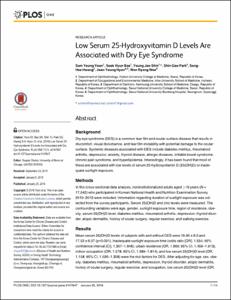Low Serum 25-Hydroxyvitamin D Levels Are Associated with Dry Eye Syndrome
- Keimyung Author(s)
- Hwang, Sang Hee
- Department
- Dept. of Dentistry (치과)
- Journal Title
- PLoS One
- Issued Date
- 2016
- Volume
- 1
- Issue
- 25
- Abstract
- Background
Dry eye syndrome (DES) is a common tear film and ocular surface disease that results in
discomfort, visual disturbance, and tear film instability with potential damage to the ocular
surface. Systemic diseases associated with DES include diabetes mellitus, rheumatoid
arthritis, depression, anxiety, thyroid disease, allergic diseases, irritable bowel syndrome,
chronic pain syndrome, and hyperlipidemia. Interestingly, it has been found that most of
these are associated with low levels of serum 25-hydroxyvitamin D (25(OH)D) or inadequate
sunlight exposure.
Methods
In this cross-sectional data analysis, noninstitutionalized adults aged 19 years (N =
17,542) who participated in Korean National Health and Nutrition Examination Survey
2010–2012 were included. Information regarding duration of sunlight exposure was collected
from the survey participants. Serum 25(OH)D and zinc levels were measured. The
confounding variables were age, gender, sunlight exposure time, region of residence, obesity,
serum 25(OH)D level, diabetes mellitus, rheumatoid arthritis, depression, thyroid disorder,
atopic dermatitis, history of ocular surgery, regular exercise, and walking exercise.
Results
Mean serum 25(OH)D levels of subjects with and without DES were 16.90 ± 6.0 and
17.52 ± 6.07 (p<0.001). Inadequate sunlight exposure time (odds ratio [OR], 1.554; 95%
confidence interval [CI], 1.307–1.848), urban residence (OR, 1.669; 95% CI, 1.456–1.913),
indoor occupation (OR, 1.578; 95% CI, 1.389–1.814), and low serum 25(OH)D level (OR,
1.158; 95% CI, 1.026–1.308) were the risk factors for DES. After adjusting for age, sex, obesity,
diabetes mellitus, rheumatoid arthritis, depression, thyroid disorder, atopic dermatitis,
history of ocular surgery, regular exercise, and occupation, low serum 25(OH)D level (OR,
1.178; 95% CI, 1.010–1.372) and deficient sunlight exposure time (OR, 1.383; 95% CI,
1.094–1.749) were the risk factors for diagnosed DES.
Conclusion
Low serum 25(OH)D levels and inadequate sunlight exposure are associated with DES in
Korean adults. These results suggest that sufficient sunlight exposure or vitamin D supplementation
may be useful in DES treatment.
- Keimyung Author(s)(Kor)
- 황상희
- Publisher
- School of Medicine
- Citation
- Sam Young Yoon et al. (2016). Low Serum 25-Hydroxyvitamin D Levels Are Associated with Dry Eye Syndrome. PLoS One, 1(25), 1–14. doi: 10.1371/journal.pone.0147847
- Type
- Article
- ISSN
- 1932-6203
- Appears in Collections:
- 1. School of Medicine (의과대학) > Dept. of Dentistry (치과학)
- 파일 목록
-
-
Download
 oak-2016-0148.pdf
기타 데이터 / 259.96 kB / Adobe PDF
oak-2016-0148.pdf
기타 데이터 / 259.96 kB / Adobe PDF
-
Items in Repository are protected by copyright, with all rights reserved, unless otherwise indicated.